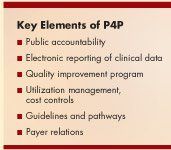Oncologists Must Learn to Manage Clinical, Financial, & Operational Costs
"Declining reimbursement rates are forcing oncologists to manage their practices more efficiently,"
ATLANTA"Declining reimbursement rates are forcing oncologists to manage their practices more efficiently," Thomas R. Barr, MBA, executive director of Oncology Metrics, said at the oncology business management session of the American Society of Clinical Oncology 42nd Annual Meeting.
In today's fiscally challenged environment, he said, there are meaningful cost and care improvement opportunities available within three domains in the typical medical oncology practice: clinical, financial, and operational.
"The clinical domain is the area that physicians are trained to manage. Historically, if oncologists were able to manage the clinical aspects of their practice well, the rest took care of itself," he said.
Mr. Barr noted that in today's environment the financial domain has become increasingly important; however, few clinicians have proper training in areas such as purchasing, capital accumulation and management, accounting, billing and collection, and return on equity investment. "Consequently, this domain is where a good practice business manager comes into play," he said.
The operational domain deals with "how processes within the practice work, or don't work, to support each other," he said. The operational domain is where the interactions between the clinical chart and billing process are made; drug inventory is managed; and scheduling, patient processing, new patient intake, patient collections, infusion chair management, and all of the other interactions where information or materials are recorded, purchased or used, he said.
Operational Efficiency
Elaine L. Towle, CMPE, program director, Oncology Metrics, explained that private oncology practices are faced with numerous issues such as new billing codes, another demonstration project, pay-for-performance initiatives, reimbursement threats, and cost containment pressures. "Accordingly, we are forced to make tough 'operational efficiency' decisions about how to treat and support our patients," Ms. Towle said.
She defined operational efficiency as the ability to produce the desired effect with a minimum of effort, expense, or waste. It's important to focus on the largest expenses first, she said. The largest area of expense is drug expenditure, (62%), followed by physician expense (26%). The focus of her presentation was physician efficiency and expense.
One way to increase physician efficiency and reduce expense, Ms. Towle said, is to introduce more mid-level providers, such as nurse practitioners or physician assistants, into the practice. "Mid-level providers can help increase your patient volume at less expense than adding a new physician. Mid-level providers also can do follow-ups, creating more time for you to do consults and add new patients," she said.
Studies show that upward of 90% of oncology patients who see nurse practitioners or physician assistants are satisfied with their care.
"It's important to note," she said, "that Medicare will reimburse for services furnished by mid-level providers in the same manner as if the services were provided by a physician." Finally, she said, mid-level providers actually help all three domains of an oncology practice operate in a more cost-efficient and value-added manner.

Pay-for-Performance
The session's final speaker, Harvey D. Bichkoff, MPH, CEO, California Cancer Care, Marin County, gave an overview of the current pay-for-performance (P4P) initiative. "P4P is based on purchasers, providers, and consumers of health care collaborating on program goals that reduce costs and reward quality," Mr. Bichkoff explained. He described the key elements of P4P (see Table) and listed the specific components of P4P as it applies to an oncology practice:
• Reporting of performance needs to be validated by an independent third party.
• Standard and recognized measures must be attainable.
• There must be predictable costs and benefits with timely rewards.
• There must be meaningful incentives: 5% to 10% of physician revenue needs to be at risk for behavior change.
Mr. Bichkoff pointed out that large medical groups are better positioned for P4P programs because of their ability to adopt information technology, utilize guidelines, and negotiate with payers on sharing arrangements. But as he pointed out, 63% of physicians are in groups of six or less, and thus lack the marketing power and resources of large groups.
He said that his own group began instituting steps to measure quality in 1995. They focused on use of chemotherapy and growth factors, use of ER and hospital, ability to order surveillance mammograms on early-stage breast cancer patients within a year of diagnosis, use of hospice and median length of hospital stay, and site of patient death (home vs hospital).
They then presented their quality and outcomes data to the medical directors of health care plans in the area (after identifying the decision makers at each plan). If negotiations for more pay for better quality failed, "we had the will to walk away from a bad deal," he said.
He noted that the ability to report clinical data electronically is very important and recommended that practices adopt an electronic medical records system. He said that California Cancer Care has a task force to come up with an electronic office. "We're working toward a paperless system," he said.
He also urged practices to participate in ASCO's Quality Oncology Practice Initiative (QOPI) as a "legitimate way to get a quality program going with a very low investment."
Newsletter
Stay up to date on recent advances in the multidisciplinary approach to cancer.
Elevating the Quality of Cancer Care via Cross-Department Collaboration
Experts from Sibley Memorial Hospital discuss how multidisciplinary work has enhanced outcomes such as survival and resource use at their institution.